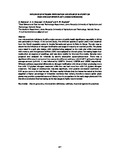| dc.description.abstract | Iron micronutrient deficiency is still a major concern of public health significance especially in Africa and particularly in Kenya. In the current study, five different species of spider plant were obtained from the World vegetable centre in Arusha Tanzania and grown in Ruiru in Kenya. The aim was to determine the influence of nitrogen fertilization and stage of maturity on nutrient profile. The plants were raised in a split plot design, with varieties being assigned to the main plot while treatments with manure, and nitrogenous fertilizer (CAN) were assigned to the sub plots. Harvesting began four weeks after emergence of seedlings, and was done weekly for the next five weeks. Samples were
prepared and analysed for minerals by atomic absorption spectrophotometer. There was a significant difference in amount of iron across the different cultivars, with MLSF17 giving the highest average amount (p≤0.05). It was followed by UGSF14, Control, UGSF36 and UGSF9 respectively. Different cultivars responded differently to nitrogen fertilization with three of them producing more iron with 1.3 g/plant nitrogen treatment while the rest had more iron with 2.6
g/plant nitrogen treatment. The stage of development was also significant, with positive correlation coefficient of
0.61 as you come to the last harvest. All these results indicate that the leaves harvested at the late stagehad a higher percentage of imbedded nutrients than others, therefore mature spider plant plants may provide a potential source of dietary iron in comparison to the early stage plants and it is therefore concluded that harvesting at the late stages is highly recommended. | en_US |

